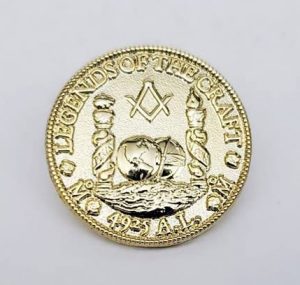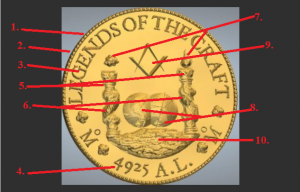Decoding the LOTC :
Traveling Man Pin
 |
 |
||
| 1 | Legendary story | coming soon |
| 2 | Spanish Coin – | For our logo, we used a Spanish silver dollar created in the early 1700’s during the European Age of Enlightenment. The coin was created in Mexico to honor King Philip V of Spain, the son of Louis, The Grand Dauphin. We chose the Philip V coin because it depicted the fable pillars of Hercules and the important statement of “Plus Ultra” – More Beyond. We converted certain elements (oh no!) and added certain innovations (aghast) found in many of our old constitutions to make it truly a masonic logo. |
| 3 | Legends of the Craft | During the 1400s to 1700s operative masons created special documents we nowadays refer to as the Old Charges or Gothic Constitution. These constitutions were usually in a similar form. They would begin with a prayer to God, a discussion of the Seven Liberal Arts and an explanation of why Geometry is the ultimate science. This was followed by the legendary history of Masonry beginning from before the flood all the way up to the Grand Assembly of 926 A.D./4926 A.L. Finally they are concluded with a series of rules and regulations for masons to follow in their work. The portion that details the legendary history is commonly known as the legends of the craft. It became the basis for many of our current craft lectures and is reflected in our tracing set. The Masonic scholar Albert Mackey wrote in his book Symbolism of Masonry, “These legends of Freemasonry constitute a considerable and a very important part of its ritual. Without them, the most valuable portions of the Masonic as a scientific system would cease to exist. It is, in fact, in the traditions and legends of Freemasonry, more, even than in its material symbols, that we are to find the deep religious instruction which the institution is intended to inculcate.” These legends are what Mary Carruthers calls Inventory Fables in her book “The Craft of Thought”. Inventory fables were stories that served like a filing cabinet. They organized information and made it easier to store so it could be easily retrieved later. According to Carruthers, many people miss the importance of Inventory Fables. They make the error of judging these stories on if they are true or false. Many of these stories were chosen and designed not due to their veracity but their ability to teach members the principles of a craft. The alchemist were famous for embedding their various formulas and processes into weird and exotic stories, while the concept of stories about stars and constellations evolved out of a need to memorize the stars for the purposes of telling time, making weather predictions and navigation. This is why Carruthers writes that medieval craft “mysteries” turn out to be less mysterious (in our sense) than they are mnemonic. Geometry had a whole iconology of “mythic” animal names for complex geometrical figures, many associated with the craft of builders.” |
| 4 | 4925 A.L. | A.L. (Anno Lucis, “the year of light”) refers to the Masonic practice of using 4000 B.C. as year zero, so while we would say 2018 A.D. the Masonic calendar would say 6018 (4000 + 2018 = 6018). The year 4925 A.L. (925 A.D.) reminds us of a young prince named Athelstan who ascended the throne of England. Athelstan favored masons and gave royal permission for a grand assembly of Masons in 4926 A.L. (926 A.D.). The purpose of this grand assembly was to discuss the best way to govern the craft of masonry in the realm and to improve any faults found in it. We “mythically” trace our current craft from this event. |
| 5 | Two pillars | The two pillars featured on the original Spanish coin was said to represent the Pillars of Hercules. Legend has it that the Greek demigod and hero Hercules traveled around the known world completing 12 labors. One of the labors took him to what is now known as the Strait of Gibraltar. This is a special passageway that connects the Mediterranean sea with the Atlantic Ocean. It is said to mark the furthest extent of Hercules travel, and it became a boundary marker. The use of two pillars was a common idea that appeared in various forms – the pillars of cloud and fire discussed below, the two pillars in front of Solomons Temple which were adapted in legends by masons both operative and speculative, the High Priestess card in the Tarot deck featured two pillars, and the father of modern science Sir Francis Bacon also made use of the pillars in his book Noucus Organis. On our coin, the two pillars are the central symbol, the one which gives the majority of the elements its form. It is both an invite to travel and a warning as well. |
| 6 | “Plus Ultra” | Latin term for Beyond, signifying that there is more to learn and see. Previously it was written as Nec Plus Ultra, meaning nothing more beyond, signifying that there was nothing more beyond. We decided to preserve this concept of “more beyond” as a metaphor for the continual search for light. |
| 7 | Cloud and fire | Exodus 13:21 – “By day the LORD went ahead of them in a pillar of cloud to guide them on their way and by night in a pillar of fire to give them light, so that they could travel by day or night.” There are some who said the two pillars in front of King Solomon’s Temple represent the pillars of cloud and fire. For our purposes, we felt the scriptures teaches a powerful lesson of faith and hope in the power of deity whether in dark or in the light. |
| 8 | Two worlds | the original coin, featured two globes representing Spain’s dominance in both the old world and the new. Our coin features two spheres, one celestial and the other terrestrial. The spheres allude to man’s use of geometry to trace both the heavens and the earth and to master the two worlds, the spiritual and the material. |
| 9 | Square n compass | while it marks this coin as Masonic, we also see it as our shining star and guide light. We also hold to the Vitruvian idea of the square representing the natural, and the circle the spiritual. |
| 10 | New world portal | Portals where usually considered doorways to far off places full of wonder, fun, mystery, and danger. Entering portals on purpose was usually undertaken by one seeking adventure or arcane knowledge. It takes fortitude to enter and usually marks the start of a quest. Our portal is an idyllic vision of what awaits the man who ventures forth. |
| 11 | Grand Lesson | https://youtu.be/1SmLHecAlDg?t=1m22s |

Recent Comments